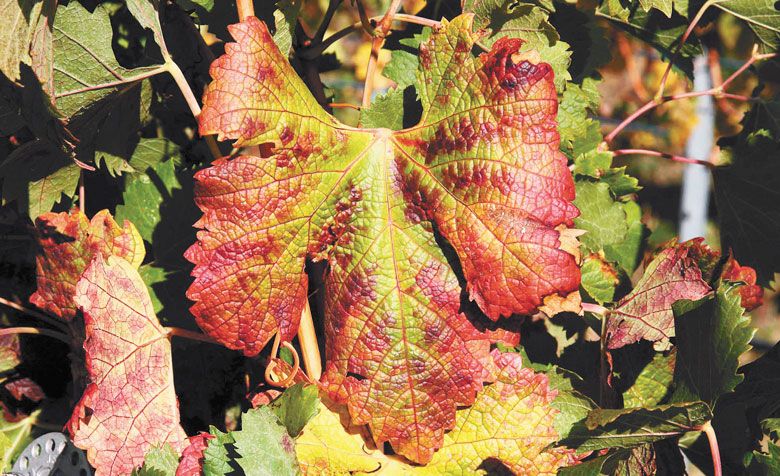Beating Red Blotch
Grapevine virus an emerging, concerning menace
By Ruty Gaffney
As vintners in Oregon recover from a compact and early 2015 harvest, and concern themselves with the vestiges of a threatening drought, there is apprehension about a new threat. An aggressive virus producing Grapevine Red Blotch Disease (GRBV) is pervasive in California vineyards and emerging in Oregon vineyards as well.
The red blotch virus is one of some 65 different viruses identified in grapevines since 1962, but it is different from most other known grapevine-infecting viruses in that its genetic material is DNA, rather than RNA. It is a member of a new genus in the geminivirus family, Geminiviridae, which carries the name GRBaV, or “Grapevine Red Blotch-Associated Virus,” to describe its association with the grapevine and red blotch disease.
GRBV is indiscriminate, infecting many cultivars, and has been found in first leaf as well as mature plantings. It is widely distributed in vineyards of the U.S. but has not been reported outside North America.
The disease was first discovered in 2008 by two researchers at the University of California, Davis in Cabernet Sauvignon vines at the Davis Oakville Station Experimental Vineyard in Napa Valley. However, recent testing of specimens originally collected by U.C. Davis Professor Harold Olmo, between 1937 and 1950, revealed a Sonoma County specimen that tested positive in 1940, indicating GRBaV was present in California vineyards 74 years ago.
Researchers have found that the symptoms of GRBV in red-berried grapevine cultivars first appear in June to July in the Northern Hemisphere as irregular blotches on older leaf blades on the basal portions of shoots. The blotches can expand and coalesce across most of the leaf blade and progressively move toward the top of the canopy late in the season — August to October in the Northern Hemisphere. There are variations in reddening, depending on the cultivar and rootstock.
The changes resemble those produced by the Grapevine Leafroll-associated Virus (GLRaV), but the leaf margins in GRBV do not roll downward, and the leaf veins in GRBV turn partly or fully red while leafroll has green veins. The visual diagnosis of GRBaV-infected vines can be challenging, since grapevines often are infected with multiple viruses, including leafroll, making DNA-based assays the only reliable method of accurate diagnosis. Confounding the diagnosis is the determination that vines can test positive for the virus but have no symptoms or symptoms may appear in one vintage and not another.
The effects of red blotch disease are much more calamitous than leaf-
roll. Sugar levels in grapes grown on vines affected by red blotch can suffer a Brix reduction of up to six degrees, much more than is seen with leafroll-infected grapevines. Additionally, in comparison to wines from non-affected vines, wines produced from diseased vines can present the following challenges: (1) delayed ripening; (2) reduced berry weight; (3) smaller yields; (4) reduced pH; (5) elevated titratable acidity; (6) diminished color in red wines; and (5) altered phenolics and tannins.
Anita Oberholster, of the Department of Viticulture and Enology at U.C., Davis, has reported research on wines made from Chardonnay, Merlot and Cabernet Sauvignon grapes from vines that tested positive for GRBaV. Besides lower Brix levels, the bottled red wines showed reduced fruit character, “artificial fruit” flavors, and a thinner mouthfeel marked by green and “granier” tannins.
According to Dr. Judit Monis, Plant Health Services Division manager of Eurofins STA Laboratories in Gilroy, California, the confusion with leafroll, nutritional deficiency, late season dormancy, insect feeding damage, environmental stresses, soil conditions and fungal pathogens have delayed the identification of GRBV in domestic grapevines. The possible emergence of a more virulent strain of GRBaV and the failure to institute practices to curtail it has led to the spread of red blotch.
Eurofins STA Laboratories developed a DNA-based polymerase chain reaction (PCR) assay soon after GRBaV was first reported at the Congress of the International Council for the Study of Virus and Virus-Like Diseases of the Grapevine (ICVG) in 2012. PCR can detect GRBaV in any tissue of the vine, including leaf blades, petioles, clusters, green or dormant canes, cordons and trunks during any season. The virus is discoverable before the onset of symptoms in the affected grapevine.
The exact origin of GRBaV is unknown. Transmission methods of red blotch disease are not clearly determined, although it is certain that grafting and propagation with infected scion and rootstock can spread the virus. There are conflicting opinions on spread of GRBaV in vineyards by pruning and harvesting.
The existence of a vector has been suggested by (1) an increased incidence of red blotch disease over time in young, healthy vineyards adjacent to old, infected vineyards; (2) short-distance spread of the virus; (3) clustering of infected vines in some vineyards; and (4) the increase in diseased vines over time.
Every field test over the past three years has failed to find evidence of an insect transmission. Entomologist Dr. Kent Daane, of UC, Berkeley, does not believe there is any conclusive evidence yet that suggests that any insect vectors should be treated with insecticides because of red blotch disease.
Bob Martin, a research plant pathologist for the USDA-ARS Horticulture Crops Research Unit in Corvallis, remarked on the spread of red blotch in Oregon.
“Red blotch occurs in Oregon for sure, based on what I have seen and testing we have done,” he said. “It has been discovered in about 15 to 20 vineyards by early 2014, with only a few vines affected in some vineyards while the signs of infection are pervasive in others. There are different rates of spread depending on whom you talk to, but very little work has been done with tagging vines and looking year after year to monitor spread.
“It appears to be moving very slowly in the Willamette Valley and is spreading in Southern Oregon, but I am not sure how fast,” Martin continued. “We know it’s a problem, but we don’t know how severe it is, and we don’t know how to control it.”
There is currently no cure for GRBD and no proven treatments that can restore normal grape quality in infected grapevines. Dr. Mark Fuchs, of the School of Integrative Plant Science at Cornell University, recommends that symptomatic vines be tagged in the fall and removed during the dormant season when insect activity is at its lowest. If greater than 25 percent of a vineyard is diseased, the entire vineyard should be replaced.
One can speculate the three-year drought in California and other climate changes have contributed to the emergence of a more aggressive or, at least, opportunistic red blotch virus.
Respected California vintner Ted Lemon noted, “There is no doubt that viruses can remain dormant in grapevines for many years. Like humans, I would expect that stress, including drought, could favor expression of the virus. As for the mechanism(s) that induce expression, that is a million dollar question.”
Some have suggested that global climate change has driven the virus to migrate from tropical climates to new areas.
It is not surprising that red blotch disease is present in Oregon since 95 percent of Oregon grapevine nursery stock comes from California, and potentially infected plants may have arrived before testing for GRBaV began in 2012. The health of foundation stocks and nursery stocks is critical to insure vines are clean as possible in the future.
The new Grapevine Foundation Block of Russell Ranch at University of California at Davis FPS was tested in 2013 and is completely free of GRBaV. This vineyard will become the primary source of wood for certified nurseries in the coming years.
At the present time, GRBaV is widely prevalent in California Department of Food & Agriculture (CDFA)-certified grapevine increase blocks, especially scion blocks. It is also found in CDFA-certified rootstock blocks but at a lower frequency than in scion materials. GRBaV is frequently found in non-CDFA-certified scion field selections and clones. Nurseries are establishing new increase blocks distant from existing blocks and other vineyards so as to provide clean rootstock and scion cuttings in the future.
Until then, only certified grapevine material that has been screened for viruses and certified free of GRBaV should be planted. Growers should consider independent lab testing for all CDFA-certified stock until proper protocols are set up for dealing with red blotch disease. In no case should new plantings be propagated from any vines in an existing vineyard, even asymptomatic ones, unless the vines have been tested for known viruses.
Grapevine material has never been truly free of viruses. So although attempts to produce clean vine material is credible, the most important issue concerning red blotch, as noted by Michael Anderson, of the Department of Viticulture and Enology at U.C., Davis, “is understanding the mechanism(s) of vine-to-vine spread. It is one thing to do everything you can to ensure clean planting material, but it is quite another to keep it that way.”
In late 2014 and again in December 2015, a group of growers, nursery operators, Oregon Watershed Restoration Inventory (OWRI) faculty and Oregon Department of Agriculture (ODA) plant health scientists convened to share information, provide an overview of the grapevine virus situation in Oregon vineyards, and plan research into management. ODA plant pathologists together with the Oregon Wine Board planned to apply for an ODA specialty crop block grant to do a survey of red blotch in Oregon vineyards.
Rusty Gaffney, a retired ophthalmologist, is the author of The Prince of Pinot, an online newsletter dedicated exclusively to Pinot Noir. The blog’s bi-weekly PinotFile features wine reviews and more.











